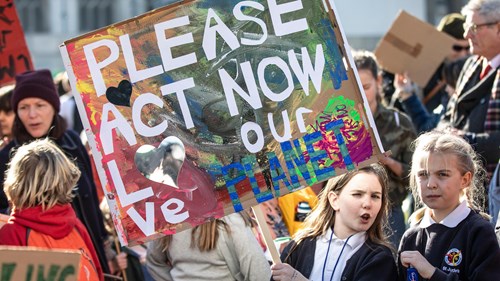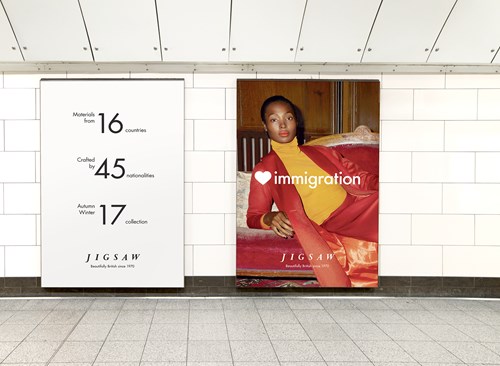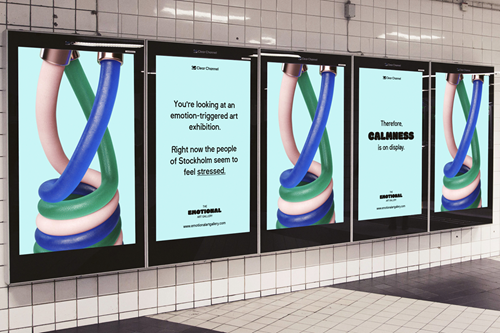INNOVATION IN A CRITICAL CONTEXT | article | Tuesday, July 2, 2019
BRANDS IN TIMES OF FURY

For many years, the common belief was that conflicts were isolated events in harmonious societies. Currently, however situations such as social inequality, climate change, aggression against minorities, racial hatred, sexual discrimination, femicides, school attacks with weapons, among others, have become increasingly more dominant and are having an impact on people’s daily life. These are no longer abstract themes, but tangible issues that compel us to take a position because they influence and modify our reality. The anti-migrant diatribe on Brexit, for example, affects a huge number of people of mixed races, including immigrants with decades of experience in the United Kingdom or families with some non-British members. Not only are legal factors at stake, but also people’s identities.
In a polarized society where companies are often targeted as the cause of many problems, distrust and suspicion abounds. The only certainty is uncertainty. This scenario then impacts changes in behavior, as well as changes in values, and has consequences on customers’ purchasing decisions. Choosing products, and services and connecting with brands, becomes evermore difficult.
Hence, what role can brands play? How can they adapt to this new context dominated by conflict? How should they rethink products, services and experiences so that they are relevant in this scenario full of tensions? In short, how does a brand innovate in times of fury?
Today we live in a context characterized by permanent conflicts. Social inequality, the origin of many global problems, is at its highest level in Europe and America: 79% USA, 59.8% Germany, 52.5% United Kingdom, 50.6% France and 57.7% Chile, measured as a percentage of the wealth owned by the top 10% of the population, according to OECD. Social protests are multiplying around the world, with Gilets Jaunes in France being the most evident sign of growing social anger. In this context, some key questions emerge in the market, for example: is it appropriate to speak of luxury in such inequitable societies, what role can brands play in societies in crisis or how do you rethink stores in violent environments. The images of Avenue Montaigne in Paris with its luxury shops completely covered with wooden planks to hide their windows and signs - thus preventing protesters from unleashing their fury on them - is a scenario that could repeat itself in the future. Modified urban landscape as a result of growing activism, and radical expressions without online filters transferred to the offline.
There are other important problems that are surfacing in western societies. The feminist movement provokes multiple debates around the role of women and issues, such as gender violence, the legalization of abortion, and the inequality of wages between men and women. This causes a lot of tension and impels change in the patriarchal society value system. This, in turn, creates brand rearrangement: either a brand seeks to empathize in depth with these claims, or it attempts not to make mistakes in the discourse in order to prevent feminists from unleashing their fury. Far from protesting on social networks, people are taking to the streets to affirm positions and are using their bodies to transmit messages.

Moreover, there is an exacerbation of fear and a growing feeling of risk. The catastrophic forecasts on climate change are impacting children and adolescents psychologically. These kids have grown up hearing about this danger, and it has now become, in many countries, one of their biggest concerns and sources of fear. It has even caused them to take initiative and organize school strikes to alert the general public on the subject. Their position on consumption is strongly influenced by the value of circularity and caring for the environment. In fact, they are the main drivers of practices such as the purchase of second-hand products – which is experiencing a dramatic growth -, the rental of products and subscription systems over ownership.
The projection of this scenario indicates that in the next 3 years, conflicts will not diminish. On the contrary, they will increase and convulse daily life. Driven by such a threatening context, people cannot remain indifferent, but must take a position on current issues. A compelling example is the exhibition on activist design entitled "Hope to Nope: Graphics and Politics 2008-18" at the Design Museum (London) which featured over 20 artists: when the museum decided to rent the atrium to the defense company Leonardo for a private event – one of the main suppliers of weapons in the world - they expressed their disagreement by withdrawing their works.
Brands must therefore consider that purchasing decisions will be immersed in a reality of great concerns, fears and risks. Knowing how to manage these tensions will be critical. And when designing products, services and experiences, it will be even more essential to know how to recognize the various nuances of the social zeitgeist, including the most relevant problems and conflicts of the day. A clear example is the controversy surrounding the sweatshirt from the Fall-Winter 2019 Burberry collection that featured a rope hanging from the neck – supposedly a tribute to the "adventurer" Thomas Burberry. The public associated the detail with suicide and generated a negative reaction in social networks under the slogan "suicide is not fashionable". In Britain, where the increase in mental illness and suicidal thoughts in adolescents is increasing, that design was inappropriate, forcing the brand to withdraw the garment from the market.
People will exercise a strong daily, intermittent and simultaneous activism, leading to the emergence of personal contradictions in a process of transition between paradigms. There will be an effort to align new life values with coherent consumption patterns. The advertising campaign "Love Immigration" (2017) by British fashion brand Jigsaw was created in favor of immigration, explicitly making people aware that its collection had been designed by a team of 45 different nationalities and manufactured in 16 countries: a powerful response to Brexit and ideas about the so-called "British values" that are being lost through the movement of people between countries. Along the same lines is the Nike campaign “Just Do It, 30th anniversary ̈ (2018) featuring the American football athlete Colin Kaepernick, former field marshal, who was the first to get on his knees during the National Anthem to protest against police brutality and racial injustice. The brand adopted a clear political position generating a net division among its consumers: some even decided to light their Nike shoes on fire in protest.

Brands can no longer be naive. People want companies to take a stand. Several studies indicate that, for example, 81% of Americans want companies to take positions in the face of important societal problems, even when it may be controversial. The Edelman Earned Brand study of 2018 reveals that almost two-thirds (64%) of consumers worldwide now buy by belief, a remarkable increase of 13 points since 2017. According to research published in the Harvard Business Review, 64% of Consumers who have established a relationship with a brand cite "shared values" as the main reason for that relationship. This corresponds to an increase in the number of consumers actively seeking information on the position of companies on important social and political issues, with young people (42%) being the most proactive when it comes to this research.
Identifying a brand’s values in a transparent manner, the level of traceability of products, the sustainability of production processes and everything that links them with the issues that concern consumers will be a requirement for success. Companies will need to become a means, not an end, in generating debate, reflection and change promotion. They will need to consider conflict as a useful element in order to distance themselves from harmful aspects and thus reaffirm their harmonious relationship with like-minded consumers. "Unfluencer - Designing the Designer" was an immersive experience designed by the Swiss firm Freitag - traditionally associated with recycling and sustainability. During the 2019 Milan Design Week, they offered a reflection on, and confessions of, consumers’ and designers’ “sins”. The brand wanted to start a sincere discussion on bad design and purchase mistakes like unsustainable product choices, all within the context of a fun experience. The exhibition featured a confessional where people could talk about design and consumption “sins” in a confidential dialogue with a ‘confessor’. They also enabled a wall on Twitter so that people could share their mistakes anonymously and redeem themselves. In summary, in order to transform into a relevant brand in a critical context companies will have to: take a position, communicate it successfully, achieve a new type of relationship with consumers, rethink products, services and experiences, and determine if they are relevant in these times of fury in which we live.
Carrying out our lives, immersed in scenarios of risk and tension has its consequences. Certain habits and practices are having undesirable impact on people’s cognitive, emotional and physical performance. Mental illnesses, disorders caused by the excessive use of devices and social networks, loneliness, among others, are issues that are evermore present in everyday life and will intensify harmful effects in the future. In the US, 86% of adults are 'constant checkers' of social networks; in the United Kingdom, 41% of young adults suffered racial harassment online in 2017; 16 million people in the world were victims of identity fraud in 2017; 35% of American adults cannot get enough sleep; one in three Argentines suffer from a mental disorder - and anxiety is the most common one; in the United Kingdom, there was a 68% increase in girls’ hospital admissions for self-harm; in Mexico, 2.5 million adolescents between 12 and 14 years old suffer from depression (2018). Faced with these symptoms, innovation will be about making connections and building relevant relationships with consumers who are submerged in situations of stress, cognitively fatigued and physically debilitated.
Interest in improving quality of life leads people to seek alternative solutions based on plants with beneficial health properties, such as algae and cannabis. The growing legalization of the use of cannabis for medicinal and recreational use, with Canada and the United States at the top, as well as the innovations of its application in a wide range of products and services, including the luxury industry, could lead to a market of 50,000 million euros worldwide by 2025. (Canada is the first State to jointly regulate its medicinal and recreational use and 33 states in the US have legalised medicinal use, while 10 states have also made recreational use legal.
Barney's New York store, in partnership with the firm Beboe, has launched a range of luxury cannabis-based products and treatments, changing the status of the lifestyle associated with marijuana use. Nightfoods is a new ice cream line that complements the human sleep cycle to help people sleep better. Chubby Cloud was an installation designed by Anya Hindmarch at London Fashion Week that offered "the largest bag of beans in the world" for visitors to relax and recover, which also included the reading of a bedtime story, a guided meditation and a lecture on the circadian rhythms of sleep. In partnership with The Sleep School, a clinic that helps people improve their sleep, Ikea offers tutorials on how to get a "glorious" night of sleep in sessions that include relaxing drinks and tips on how to breathe. Ikea also offers a "sleep pod” where clients can learn how to achieve quality sleep complemented by a “pillow pairing" event – a speed-dating-style happening where people can pick out the best pillow for them.

Blackout is an athletic track developed by Asics designed to train the minds of runners. It’s a meditative space, free of distractions: totally black and with dim light, no colors, no technology, no decorative elements, and no music. The digital well-being tools developed by Google seek to generate a better relationship between users and their phones by limiting the time that people are exposed to screens. A control panel allows users to establish “use limits” in order to control the amount of exposure to a certain application. When the time-limit approaches, a notification appears warning the user that they are almost out of time. When the self-imposed limit is reached, the application stops.
Viable strategies must include an in-depth understanding of emotional states. Companies will have to act in a straightforward manner in order to reduce the mental disorders that afflict people and affect their ability to make decisions. They will need to offer products, services and experiences that lower tension levels, allowing people to manage conflict and uncertainty more easily. They will need to create sensory scenarios so that consumers can focus on experiences. And they will need to find the right moments in which to transmit messages.
Kia is working to address the stress levels of travelers with its Adaptive Real Time Emotion Driving System (R.E.A.D.). The system picks up the driver’s emotions, detected by facial recognition technology. Based on Artificial Intelligence, it analyzes facial expressions, heart rate and electrodermal activity to determine the emotional state and then adjusts the interior of the car, such as lighting or music, to improve the driver’s mental state.

The Gallery of Emotional Art developed by Clear Channel and the study Affairs in Stockholm, uses real time travelers’ emotions to replace advertisements on public roads with works of art with the intention of combating negative feelings. A customized algorithm reacts to real-time public data collected from Google searches, news articles, social networks and travel traffic information to assess whether people in the Swedish capital feel sad, anxious, tired, stressed, irritated or afraid. This information is then used to project one of six works of art that expresses an opposite emotion (happy, energized, calm, safe, peaceful and loving) over 250 digital screens, in an attempt to change the public’s mood.
In conclusion, becoming a relevant brand in a critical context will require taking a position on issues that affect people and acting accordingly to facilitate the alignment of consumption patterns to new emerging values, as well as helping people manage conflict and reduce the negative consequences caused by living in times of fury.
* Article based on the talk "Marcas en Tiempos de Furia" presented at the seminar ‘Circuito de Tendencias’ of INTI, Argentina, April 2019.
